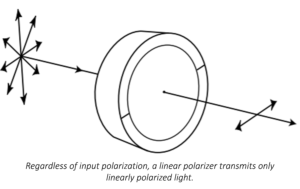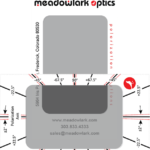 Dichroic Polarizers
Dichroic Polarizers
Meadowlark Optics offers an extensive line of dichroic polarizers made from both polymer and treated glass materials. Dichroic refers to the selective polarization absorption of the anisotropic polarizing material (Diattenuation). These polarizers are usually constructed by laminating a thin, stretched and dyed polymer film between two polished and antireflection-coated glass windows. The resulting compact component offers excellent value and is often the best choice for flux densities below 1 watt/cm2. Selecting the appropriate dichroic polarizing material enables excellent extinction ratio performance over the wavelength range from 310 to 5000 nm. Due to small variations in the polarization material, extinction ratios degrade over larger apertures for all dichroic polarizers. Meadowlark Optics has improved the transmission of dichroic polarizers with high-efficiency, broadband antireflection coatings on the glass windows used in our product design. Laminated glass construction contributes to a substantial improvement in transmitted wavefront distortion. Our polarizer assembly greatly improves the product durability, allowing for easy and repeated cleaning.
Meadowlark Optics also offers a line of high contrast dichroic glass polarizers for the near and mid infrared regions of the spectrum up to 5000 nm. High throughput and contrast make these polarizers an excellent choice for near infrared requirements. Key advantages of dichroic polarizers include superior angular acceptance and extreme flexibility for custom shapes and sizes. Please call one of our Sales Engineers for assistance.
Ideal linear polarizers allow the transmission of only one polarization state with zero leakage of all other polarization states. Rotating the linear polarizer about the optical axis changes the output plane of polarization. Thus, a perfect linear polarizer transmits only 50% of an unpolarized input beam and two perfect polarizers with their transmission axes crossed totally extinguish an incident beam. Imperfections in polarizers such as scattering sites, material defects (such as pinholes in thin films) and field-of-view effects reduce ideal polarizers’ contrast.
When choosing a linear polarizer, several key factors must be considered including: cost, wavelength range, aperture size, acceptance angle, damage threshold, transmission efficiency and extinction ratio. Extinction ratio (or contrast ratio) is defined as the ratio of transmitted intensity through parallel polarizers to the transmitted intensity through crossed polarizers. Meadowlark Optics offers polarizers with extinction ratios as high as 10,000,000:1 over the operating wavelength range.
Beamsplitting Polarizers
Beamsplitting polarizers divide unpolarized incident light into two (usually) orthogonal, linearly polarized beams. Low absorption coatings provide an excellent combination of damage resistance and extinction ratio at a moderate price. Rugged beamsplitter cubes are easily mounted and therefore designed into many instrument applications. Beamsplitting polarizers offer the unique advantage of providing two linearly polarized output beams, one transmitting straight through and the second “splitting” off at precisely 90 degrees. When necessary, the extinction ratio of the reflected beam can be dramatically improved by adding a dichroic polarizer to the output face. Meadowlark Optics offers both Laser Line and Broadband Beamsplitting Polarizers, covering visible to near infrared applications. Laser Line Beamsplitting Polarizers offer the advantage of V-type antireflection coatings, improving efficiency by limiting surface losses. Broadband Beamsplitting Polarizers are more versatile for tunable wavelength or broadband sources.
Calcite Polarizers
Calcite is a naturally occurring birefringent crystal with excellent polarization properties including very high extinction ratio and transmission efficiency. Aperture sizes are limited, since large optically uniform pieces of this natural crystal are rare. Calcite material exhibits extremely broadband transmission performance, from 320 to 2300 nm. Meadowlark Optics offers Glan-Thompson calcite polarizers. Manufactured from Grade A optical calcite material, the design takes advantage of total internal reflection to separate the two polarization components. Glan-Thompson Polarizers are recommended where a wide acceptance angle is important for overall system performance. However, the version with cemented construction limits both power handling and ultraviolet performance.
Wire Grid Polarizers
VersaLight wire grid polarizers are the modern outgrowth of the 1888 experiments by Heinrich Hertz using fine metallic wires wrapped around a non-conductive frame. Instead of manually arranging an array of fine conductive wires, lithographic techniques are used to place sub 100 nm pitch aluminum conductors on glass substrates. When incident unpolarized radiation interacts with the wire grid, differences in boundary conditions drive different behavior for the two orthogonal polarizations. Electromagnetic radiation incident on the “wires” oscillate free electrons which have a much higher mobility along the wires than in the transverse dimension. Ideally, the wires behave as a perfect reflector for the parallel field and pass 100% of the transverse field. Material defects and Joule heating reduce the contrast of the polarizer, which is also strongly affected by the wavelength of the light passing through it. (Longer wavelengths are closer approximations to the ideal solution as their wavelengths become much greater than the wire grid spacing.)
Versalight polarizers are available in large aperture sizes up to 200mm diameter with high contrast across the visible and near-infrared spectrum. They can handle relatively high power and are more durable when coated. Specially selected ultraviolet transmissive material is available on a custom basis.
Please contact a Meadowlark Optics Sales Engineer for assistance.


